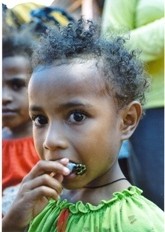 The local languages in Papua are under threat. This is the disturbing message of the United Nations Organisation UNESCO. The United Nations Cultural Heritage Fund reported that 2498 languages of the World’s existing 6900 languages are in danger of disappearing. This fact is clear from the third edition of the digital ‘Atlas of the World’s Languages in Danger of Disappearing’ presented on 19 February 2009. According to linguists, this is just as serious as the disappearance of animal and plant species. Half of all the languages that exist, have less than 2500 users. A language must have at least 100.000 users for it to exist from one generation to the next. Of the languages under threat, 219 disappeared within an 8 year period(between 2000 and 2009). All Papua languages now have the label of being ‘endangered’ but the degradation of the Tobati language is the most advanced as there are only a handful of fluent native speakers left.
The local languages in Papua are under threat. This is the disturbing message of the United Nations Organisation UNESCO. The United Nations Cultural Heritage Fund reported that 2498 languages of the World’s existing 6900 languages are in danger of disappearing. This fact is clear from the third edition of the digital ‘Atlas of the World’s Languages in Danger of Disappearing’ presented on 19 February 2009. According to linguists, this is just as serious as the disappearance of animal and plant species. Half of all the languages that exist, have less than 2500 users. A language must have at least 100.000 users for it to exist from one generation to the next. Of the languages under threat, 219 disappeared within an 8 year period(between 2000 and 2009). All Papua languages now have the label of being ‘endangered’ but the degradation of the Tobati language is the most advanced as there are only a handful of fluent native speakers left.
Content:
1.Only six elderly speak fluent Tobati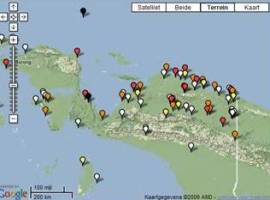
2.Bahasa Indonesia threatens local languages.
3.Contact with the outside world
4.Songs and dances at art festivals
5.Magic disappeared with the arrival of Christianity
6.Papua has 264 regional languages
7.The second largest Island of the world
8.Many local languages belong to the Papua Language Group
9.Links
10.Sources
1.Only six elderly speak fluent Tobati
Herman Rumadi Hamadi, the 88 year old chief of a Tobati tribe was unable to hide his fear when he was asked how many people were still able to speak their native language.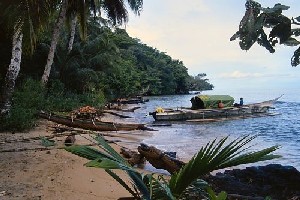 “ I am not sure, but I suspect that there are only six of us left who can speak fluent Tobati. Once they die, our language will have disappeared”, said Hamadi who himself does not always use the native tongue of his ancestors. Hamadi is right to be concerned. The six who can still speak fluent Tobati are all over 60 and the younger generation in the village all speak fluent Bahasa Indonesia. The situation is aggravated because more and more Tobati leave for Jayapura, the provincial capital. Once there, they have to use Bahasa Indonesia in order to communicate.
“ I am not sure, but I suspect that there are only six of us left who can speak fluent Tobati. Once they die, our language will have disappeared”, said Hamadi who himself does not always use the native tongue of his ancestors. Hamadi is right to be concerned. The six who can still speak fluent Tobati are all over 60 and the younger generation in the village all speak fluent Bahasa Indonesia. The situation is aggravated because more and more Tobati leave for Jayapura, the provincial capital. Once there, they have to use Bahasa Indonesia in order to communicate. “Every time someone leaves, cultural heritage is lost”.
2.Bahasa Indonesia threatens local languages
“ Bahasa Indonesia especially threatens the existence of native languages in city centres where contact with the outside world( non-Papuan) is most prominent”, said Supriyanto Widodo, Head of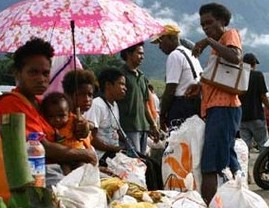 Yayapura Language Centre. The results of a study conducted by this centre in 2005 and 2006, indicate that three languages in Tobati Enggros are endangered: Kayu Pulau, Kayu Batu and Nafri.
Yayapura Language Centre. The results of a study conducted by this centre in 2005 and 2006, indicate that three languages in Tobati Enggros are endangered: Kayu Pulau, Kayu Batu and Nafri.
“ We predict that these three regional languages will disappear within three generations, unless the government and the local communities themselves take measures to save them”, said Widodo.
Assuming that a generation spans about 20 years, these regional languages will disappear within 60 years, as a result of insufficient value being attached by the local population to their own language.
3.Contact with the outside World
Tribal leader Hamadi stated that the members of the Tobati Tribe have had contact with the outside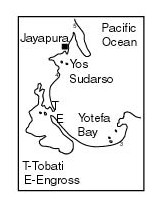 world for a very long time.In 1910 the Dutch Government set up an administrative post at Humboldt Bay. The centre expanded quickly as a result of rapid economic growth. It is therefore not surprising that Hamadi has been able to speak Bahasa Indonesia since his childhood. Intermarriage with newcomers to the area enhanced this trend. “Our grandchildren speak fluent Bahasa Indonesia. They seem not to know where their roots lie, because they have become members of the Tobati community who do not know their own language any more. How can we continue to maintain our customs, dances and special occasions in Tobati?”, one father of ten wondered. He claimed that he had been making a constant effort to pass the Tobati language on to his children.
world for a very long time.In 1910 the Dutch Government set up an administrative post at Humboldt Bay. The centre expanded quickly as a result of rapid economic growth. It is therefore not surprising that Hamadi has been able to speak Bahasa Indonesia since his childhood. Intermarriage with newcomers to the area enhanced this trend. “Our grandchildren speak fluent Bahasa Indonesia. They seem not to know where their roots lie, because they have become members of the Tobati community who do not know their own language any more. How can we continue to maintain our customs, dances and special occasions in Tobati?”, one father of ten wondered. He claimed that he had been making a constant effort to pass the Tobati language on to his children.
Papuans have lived along side each other for more than 10.000 years, but in this last century not many of the tribes seem to be able to survive. Through the ages many Papuans were happy with their existence and much better fed than many in other parts of the world. In the lowlands of New Guinea a single day of harvesting sago palm can provide sufficient food for weeks for one big family. The word ‘work’ does not actually exist in any Papuan language. It is a concept that was introduced from the outside world. Most of the inhabitants had more spare time than the ’developed world’ is able to imagine. Unfortunately, Papuans are regarded as underdeveloped and lazy by the Indonesians because they do not seek economic gain in the same way as the Indonesians do.
Through the ages many Papuans were happy with their existence and much better fed than many in other parts of the world. In the lowlands of New Guinea a single day of harvesting sago palm can provide sufficient food for weeks for one big family. The word ‘work’ does not actually exist in any Papuan language. It is a concept that was introduced from the outside world. Most of the inhabitants had more spare time than the ’developed world’ is able to imagine. Unfortunately, Papuans are regarded as underdeveloped and lazy by the Indonesians because they do not seek economic gain in the same way as the Indonesians do.
4.Songs and dances at art festivals
According to Hamadi, the traditional songs, poems and dances are not being performed anymore in the 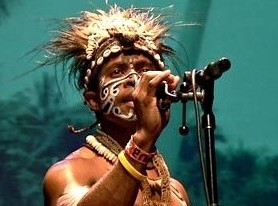 village. These songs, poems and dances do however appear in Tobati at art festivals in Jayapura and other parts of the country. These items do not originate from Tobati, but from Papua New Guinea and current Tobati artists.
village. These songs, poems and dances do however appear in Tobati at art festivals in Jayapura and other parts of the country. These items do not originate from Tobati, but from Papua New Guinea and current Tobati artists.
“That is a worry. If the Tobati Language disappears, our culture will too and we will become strangers in our own country. Many elements of our culture are not being practised anymore. Our grandchildren can’t sing and do the Serme dances. This type of dance was usually performed to greet the fishermen coming home. They do not know the Yawo dances either. Those were performed by the wood cutters who brought the new boats from the forest out to sea. Such traditions have already been lost”, said Hamadi. According to him, young people prefer to work as a civil servant or in the private sector, instead of becoming a fisherman.
“The forests that were once used by the local population to build boats, have changed into cities”. These are now full of Indonesians and Papuans have become a minority. They are of Melanesian descent and have no genetic or cultural ties with Indonesia.
5.Magic disappeared with the arrival of Christianity
Magic and various special customs started to disappear with the arrival of Christianity.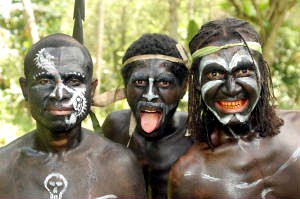 “ Traditions, magic and the belief in the ghosts of our ancestors have been replaced by hymns in Malay. There has been a gradual shift away from the use of regional languages”, said the Tobati leader, Hamadi He has been trying to convince the government to help them with maintaining their language.
“ Traditions, magic and the belief in the ghosts of our ancestors have been replaced by hymns in Malay. There has been a gradual shift away from the use of regional languages”, said the Tobati leader, Hamadi He has been trying to convince the government to help them with maintaining their language. “ If the government would provide compensation for travel and the setting up of training courses, then we would gladly pass on the language to the younger generation. We would need a number of locations in Jayapura where members of the Tobati tribe could meet to follow language courses”, Hamadi explained. Aksamina Awinero, 41, the daughter of the tribal leader Obid Awinero of Nafri Village, agreed with him
“We spoke Nafri with our children, but as soon as they went to school, they spoke more Bahasa Indonesia than Nafri”, said the mother of seven children.
“ Every one from Jayapura and Abepura was using our communal land, but our sago palm gardens have had to make room for the city and we now have to live together with all those newcomers” exclaimed the Ondoafi (tribal leader) of Enthrop village near Jayapura. The Kayu –Pulau tribe in Jayapura and the Nafri Community in Abepura have been culturally overwhelmed by the pace of development which has a major impact on their lifestyle and their native language is used less and less.
6.Papua has 264 regional languages
Data from research by the Department of Education and Culture in Jayapura showed that in 1991 only 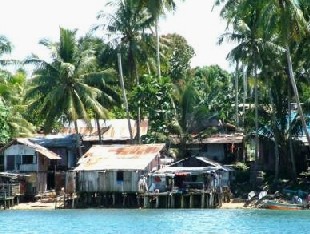 about 800 people still used the Tobati language in the villages Tobati, Enggros and Kayu-Pulay, while this is higher for the regional language Nafri which is being spoken by 1630 people. This same investigation also revealed that there are 249 languages in the Indonesian Province of Papua, which roughly equates to the number of tribes that there are. However in 2004, the Summer Institute of Linguistics( SLI) reported that Papua has 264 languages.
about 800 people still used the Tobati language in the villages Tobati, Enggros and Kayu-Pulay, while this is higher for the regional language Nafri which is being spoken by 1630 people. This same investigation also revealed that there are 249 languages in the Indonesian Province of Papua, which roughly equates to the number of tribes that there are. However in 2004, the Summer Institute of Linguistics( SLI) reported that Papua has 264 languages.
The use of Malay, later called Bahasa Indonesia, ensures that Papuans can communicate and co-operate with each other and it allows them to arrange marriages between different tribes. Although the widespread use of Bahasa Indonesia has led to accelerating development, it also heralds the death knell of the local languages in Papua. Tribal leader Widodo is well aware of this fact and he has taken measures to try and save local languages.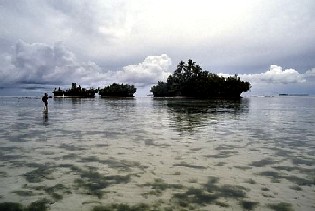
“ This (widespread use) is a welcome development for Bahasa Indonesia, but not for our local languages” Widodo commented. Widodo’s Language Centre has documented 180 languages in the whole of Papua since it started in 2002. According to Widodo.
“ We give priority to 200 of the high frequency words of every day language and more than 1000 culturally related vocabulary, which has led to a total of more than 1600 words per village”.
A number of regional authorities have also documented the use of local languages. An example of this is Biak, where a dictionary and some grammar books have been published. Local schools are required to teach( in) the Biak language. The Regional Authority of Fak Fak has funded the publication of an Iha dictionary. Despite limited resources, the Jayapura Language Centre has collated dictionaries for the following three languages: Maybrat/South-Sorong, Sentani and Jayapura. Widodo emphasized the need to work together,
“Our goal is to combine all these works and to publish a language map of this region within Indonesia”.
7.The second largest Island of the world
West Papua is the western part of New Guinea, which is the second largest island of the world.(Greenland is the biggest.) The eastern part, which was governed by Australia, has been independent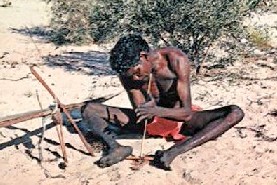 since 1975.
since 1975.
The inhabitants of New Guinea came from Asia during one of the ice ages around 50.000 years ago. These early immigrants were Negroid, as is the case for the early inhabitants of Australia. Genetic research has demonstrated that Papuans and Aborigines are related. The population of New Guinea have a dark skin and tightly curled or ‘frizzy’ hair. Because of the geography of the landscape, the different Papuan groups developed their own specific languages over thousands of years. The actual number of different languages counted varies, depending on what you call a language as opposed to a dialect.
New Guinea with 0.1 percent of the population, has 1.5 percent of all recorded languages. The language 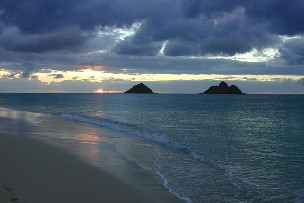 variation on this island is greater than that of all the islands of Southeast Asia, Micronesia and Polynesia put together. In 1963, when Former Dutch New guinea was handed over to Indonesia, 200 languages had been counted among 500.0000 to 700.000 Papuans.
variation on this island is greater than that of all the islands of Southeast Asia, Micronesia and Polynesia put together. In 1963, when Former Dutch New guinea was handed over to Indonesia, 200 languages had been counted among 500.0000 to 700.000 Papuans.
Today Papua has many immigrants, mostly Javanese who came to Papua as part of a transmigration policy instigated by the Indonesian Government and this has resulted in Papuans becoming a minority in their own country. It is a major contributing factor to the local languages becoming endangered.
Papua New Guinea (PNG) across the border has more than 800 indigenous languages which is more than one tenth of the world total. The Lingua Franca in this country is Pidgin( tok-Pisin) which contains many words from different languages, especially English and German, the languages of the colonial powers that reigned in this part of the world.
8.Many local languages belong to the Papua Language Group
Most of the languages of West Papua belong to what the experts call the ‘Papua Language Group’ Besides this, Austronesian languages are used in some coastal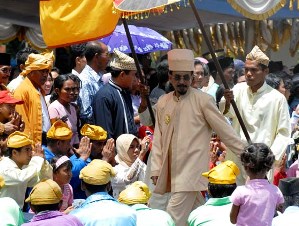 areas and on smaller islands of West Papua. The term ‘Papua Language Group’ refers to all languages spoken in the Western Pacific Region which do not belong to the Austronesian or Australian languages. Most Papuan Languages are spoken in New Guinea itself, but they also occur on some of the Solomon Islands and on a few islands in Indonesia, namely Halmahera, Timor, Alor and Pantar. One specific Papuan language is spoken on one of the Torres Islands in the eastern Torres Strait (Australia).
areas and on smaller islands of West Papua. The term ‘Papua Language Group’ refers to all languages spoken in the Western Pacific Region which do not belong to the Austronesian or Australian languages. Most Papuan Languages are spoken in New Guinea itself, but they also occur on some of the Solomon Islands and on a few islands in Indonesia, namely Halmahera, Timor, Alor and Pantar. One specific Papuan language is spoken on one of the Torres Islands in the eastern Torres Strait (Australia).
Malay has undergone a development of its own in West Papua and like in other places in Indonesia, this has produced a local variation. Papua Malay and the official Bahasa Indonesia are currently the Lingua Franca of Papua.
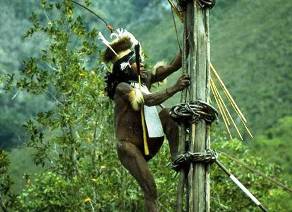 The viability of a language is first and foremost determined by the attitude of the speakers to their cultural traditions.
The viability of a language is first and foremost determined by the attitude of the speakers to their cultural traditions.
The language in which they express themselves is vital to their cultural heritage. A language and its cultural dimension become endangered when different groups come into contact with each other. Such a context does not only lead to an exchange of cultural customs and material culture, but it also has an impact on cultural prestige. A difference in technological knowledge can lead to a feeling of inferiority among the group with less advanced technology, who then tends to give up their culture, and their language in favour of the culture and language of the group with the more advanced level of technology. The general expectation is that at least half to possibly 90 percent of the 6900 languages of the world languages will be in danger of disappearing and a good number will have become extinct. Papuan languages are especially endangered because each one has relatively few speakers and their lifestyle has been culturally overwhelmed by the pace of change and development after contact with the outside world.
9.Links
- Unesco: Digital Atlas of World’s Languages in Danger of Disappearing
- Teacher Resource Kit, ‘Bedreigde Talen’( Endangered Languages) for secondary schools
– Also refer to: Atlas for Papuan Languages
10.Sources
- A number of publications from the Indonesian and Dutch media publications, among which an article by Angel Flassy in The Jakarta Post and an account on indonesialogue.com
- Advice and extra information: Bert Voorhoeve